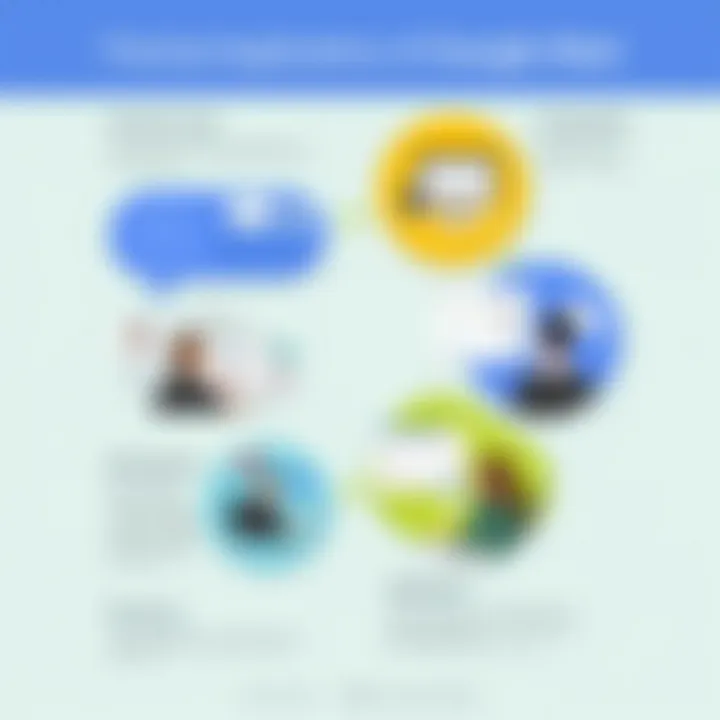Mastering Google Meet: Features and Usage Insights


Intro
In the age of virtual communication, Google Meet has emerged as a vital player in the video conferencing landscape. Created initially for enterprise users, it has broadened its reach. Providing a versatile platform for everything from casual meetups to professional conferences, it fulfills needs across various sectors. For tech-savvy individuals, business professionals, and IT experts, understanding how to navigate and utilize Google Meet effectively is more crucial than ever. This guide offers not just an overview of its features but also dives deep into its practical applications, security measures, and usability insights.
Software Category Overview
Purpose and Importance
Google Meet is part of the broader category of video conferencing software, designed to facilitate online meetings through secure, high-quality video and audio connections. In a world where remote work and global collaboration are the norms, understanding its importance helps highlight its utility. Virtual communication tools like Google Meet have become essential for maintaining interpersonal relationships, enhancing team collaboration, and fostering innovation regardless of geographic barriers.
The need for reliability and accessibility in online meetings can't be overstated. Google Meet provides a robust solution that integrates seamlessly with other applications like Google Calendar and Gmail, ensuring users can plan and execute meetings with minimal fuss. It’s crucial to understand that its value lies not just in connectivity but in promoting productivity and engagement.
Current Trends in the Software Category
As the digital landscape evolves, so does the demand for intuitive and versatile communication tools. Several trends are shaping the video conferencing arena:
- Integration with Productivity Tools: Modern solutions focus on connecting with tools like Microsoft Office, Trello, and Asana.
- Focus on Security: With increasing concerns about data privacy, features like end-to-end encryption have gained traction.
- AI Capabilities: Intelligent features like real-time captioning and background noise suppression are on the rise, enhancing the user experience.
These trends indicate a market that is rapidly adapting to the needs and expectations of users.
Data-Driven Analysis
Metrics and Criteria for Evaluation
In evaluating a platform like Google Meet, various metrics should be considered:
- User Interface (UI)/User Experience (UX): How intuitive is the platform? Are users from various backgrounds able to navigate it easily?
- Audio and Video Quality: Are there significant drops in quality when multiple participants join? How does it perform under different internet speeds?
- Security Standards: What measures are in place to protect user data and integrity of meetings?
By analyzing these metrics, one can gauge not just the technical capabilities of Google Meet, but also its feasibility as a reliable communication tool in a professional setting.
Comparative Data on Leading Software Solutions
When comparing Google Meet with other major players like Zoom or Microsoft Teams, several factors come into play:
- Integration: Google Meet excels in integrating with Google Workspace, making it a preferred choice for companies already using those tools.
- User Capacity: While Google Meet allows up to 250 participants for enterprise users, its competitors offer varied capacity options depending on subscription tiers.
- Pricing: Google Meet offers a free tier with significant functionalities. In contrast, teams like Zoom charge for certain features that might be standard elsewhere.
"Choosing the right platform hinges not just on features but also on alignment with organizational needs and user preferences."
By keeping these comparisons in mind, businesses can make informed choices about the communication tools that support their operations best.
Understanding the intricacies of Google Meet and the nuances of the video conferencing software landscape not only prepares users for effective meetings but also equips them with insights to leverage the platform fully.
For more information on Google Meet's capabilities and how they relate to various user needs, you can explore additional resources at Google’s official site Google Workspace, as well as user forums on Reddit where experiences and tips are shared.
Prolusion to Google Meet
In today’s world, where remote work and virtual collaboration have become the norm, understanding tools like Google Meet is crucial. Google Meet serves as a reliable bridge for communication, allowing teams to connect effortlessly, regardless of their physical locations. With increasing reliance on digital platforms, this guide will unravel the various layers of Google Meet, ensuring users don’t miss out on its capabilities.
Overview of Virtual Meeting Applications
Virtual meeting applications have surged in popularity amid the shift toward remote work. These platforms enable users to conduct meetings over the internet, transcending geographical barriers. Google Meet, along with others like Zoom and Microsoft Teams, has carved its niche in this competitive landscape. The significance of these tools lies in their ability to foster collaboration, enhance productivity, and maintain a seamless flow of communication.
Virtual meetings can take many forms, such as webinars, team check-ins, or client calls. This variety makes them indispensable in almost every sector, from education to corporate environments. Furthermore, the convenience of scheduling and joining meetings from anywhere is a game changer. Instead of the traditional office setups that often hinder spontaneous brainstorming sessions, these applications promote flexible and dynamic workflows.
The Evolution of Google Meet
Google Meet's journey is a testament to the rapid evolution of communication technology. Originally launched as Hangouts Meet in 2017, it was designed expressly for enterprise users. As virtual communication became central to daily operations, Google recognized the need for a more robust platform and rebranded it to Google Meet in 2020. This evolution not only marked a change in name but also a significant enhancement in features.
The platform has continuously adapted to the need for improved security, user experience, and integration with Google Workspace. Over time, Google Meet has introduced capabilities like real-time captions, embedded chat features, and advanced security measures. These evolutions illustrate a broader trend in software development: responsive innovation.
As demands grow, so does Google Meet's functionality, ensuring that it stays ahead in a competitive market. With updates released frequently, users find themselves better equipped for their meeting needs, paving the way for more productive and meaningful collaborations.


Through this guide, we will explore how to utilize Google Meet to its fullest potential, focusing on its features, best practices, and comparisons with other platforms. This deeper dive will not only equip users with the necessary skills but also allow them to appreciate the nuances that set Google Meet apart in the realm of virtual communication.
Key Features of Google Meet
Understanding the key features of Google Meet is vital for anyone seeking to optimize their virtual meeting experience. These functionalities cater to both casual users and extensive business needs, offering a blend of ease and sophistication that makes it a popular choice in today’s digital workplace. From seamless navigation to robust collaborative tools, these features not only enhance communication but also ensure that meetings run smoothly and efficiently.
User Interface and Navigation
The user interface of Google Meet is designed with simplicity in mind, making navigation intuitive even for less tech-savvy users. When you log into Google Meet, you’re greeted with a clean layout that emphasizes functionality. The main controls are easily accessible, reducing the learning curve to virtually nothing. Users can join meetings with a single click, and scheduling a new one can be accomplished from the same interface.
One notable element is the grid layout during meetings, which displays all participants in a straightforward manner. This aspect allows users to engage with one another effectively without losing focus. Additionally, tools like the chat box are conveniently placed, making real-time communication easy without disrupting the flow of the conversation.
Overall, a well-structured user interface is critical in reducing the barriers to entry for new users, ensuring that they can participate effectively from day one.
High-Quality Video and Audio
In a world increasingly reliant on video conferencing, high-quality video and audio are non-negotiable. Google Meet delivers on this front, utilizing advanced technology to ensure crisp visuals and clear sound throughout meetings. The platform adjusts to varying internet speeds, auto-scaling the video quality to maintain stability while reducing disruptions.
What sets Google Meet apart is its ability to support up to 250 participants in a single call without significant degradation in quality. This capability is particularly advantageous for businesses conducting large team meetings or webinars. Furthermore, features like noise cancellation enhance the audio experience, filtering out background noise and allowing users to focus on what truly matters – the discussion at hand.
Integration with Google Workspace
Google Meet’s seamless integration with Google Workspace fuels its appeal, especially among businesses already using tools like Google Drive, Calendar, and Gmail. This integration simplifies scheduling and sharing documents and supports a more cohesive workflow. For instance, you can easily add a Google Meet link to calendar invitations, ensuring all participants have quick access to the meeting.
Moreover, integration also means that once in a meeting, participants can collaborate using Google Docs, Sheets, or Slides instantly. This ease of access allows for real-time editing and brainstorming, enhancing productivity and ensuring that meetings are not just conversations, but active collaboration sessions.
"With Google Meet, collaboration isn’t just a buzzword; it’s a functional and engaging process that brings remote teams together like never before."
Screen Sharing and Collaboration Tools
Screen sharing is another cornerstone feature that heightens the effectiveness of meetings on Google Meet. Users can share their entire screen or specific windows, allowing for presentations, tutorials, and demonstrations. This capability proves invaluable for team training sessions or when discussing intricate projects that require visual clarification.
Additionally, Google Meet includes essential collaborative tools such as live captions and the option to record meetings for later reference. Live captions offer accessibility for participants who may have hearing difficulties or who are in noisy environments. Recording meetings, on the other hand, ensures that discussions can be revisited, fostering a culture of accountability and thoroughness.
In sum, these tools significantly amplify the collaborative powers of virtual meetings, transforming them from simple calls to integrated platforms where ideas can be cultivated and shared efficiently.
How to Set Up Google Meet
Setting up Google Meet is a crucial process for anyone looking to unleash the full potential of this platform. This segment will walk readers through the steps needed to effectively initiate meetings, ensuring that connections are made seamlessly. Getting your setup right is like laying a solid foundation before constructing a house; neglecting it can lead to problems further down the road.
Creating a Google Account
To use Google Meet, you first need a Google account. This account acts like a key, unlocking various features of Google’s ecosystem, including Gmail, Drive, and, of course, Meet itself. Without this account, connecting with colleagues, clients, or friends becomes a tedious task.
- If you already have a Google account, you’re all set. Just sign in at Google Accounts.
- Don't have one? No big deal; it’s as easy as pie. Head over to the same link and hit the "Create Account" option. You’ll be guided through entering your name, desired email, and password. You might encounter a few verification steps like confirming your phone number or email, but nothing too complex.
Setting up a Google account opens doors, allowing you to customize your settings and tailor your experience according to your needs. Remember, it’s not just about Google Meet. With your account, you can navigate through the countless utilities Google offers.
Scheduling a Meeting
Once you've created an account, scheduling a meeting is next on the agenda. Summoning everyone for a meeting is easier than herding cats when you know how to do it right.
- Access Google Meet: You can initiate a meeting directly from the Meet website or directly through Google Calendar.
- Start a New Meeting: If you’re on the Meet homepage, click on the “New Meeting” button. This offers you options like "Create a meeting for later" or "Start an instant meeting."
- Setting a Time: When using Google Calendar, create a new event. In the event details, you can set the date and time.
- Add Invitees: Input the emails of anyone you want to join. This is where you can set up your guest list without breaking a sweat.
- Meeting Link: Google Calendar will automatically generate a Meet link for your scheduled time. Share this link with your participants, either directly via calendar invite or email.
Scheduling is not merely about picking a time; it also involves being considerate of participants’ availability and time zones. Transparency and clear communication make for smoother meetings.
Joining a Meeting
Joining a meeting can feel like stepping into a whirlwind, especially if you’re new to the platform. But fret not! Here’s how to join a meeting without breaking a sweat.
- Using a Link: If someone sent you a Google Meet link, simply click it. It’ll direct you to the meeting screen, where you can adjust your audio and video settings before joining.
- From Google Calendar: If the meeting is on your calendar, click the event, and you’ll see a “Join with Google Meet” option. It’s as straightforward as falling off a log.
- Meeting Code: Alternatively, if you have a meeting code, go to the Meet homepage, enter the code in the relevant field, and voila—you’re in!


Getting into a meeting quickly saves precious time, especially in professional settings where every second counts. Make sure you’re aware of the meeting etiquette before you join, so you start off on the right foot.
In summary, setting up Google Meet efficiently is a step that can greatly enhance your virtual interfacing experience. Be it creating your Google account, scheduling or joining meetings, each action taken is vital for effective communication.
Utilizing Google Meet Effectively
Using Google Meet effectively is crucial, especially in today’s world where remote work has become the norm. Efficient utilization of this platform enables smoother interactions and improved collaboration. There are several elements to consider when you want to make the most out of your virtual meetings. Understanding how to engage your team, manage discussions, and handle large groups can make all the difference in reducing confusion and maximizing productivity.
Best Practices for Remote Collaboration
Collaborating remotely brings its own challenges, offering unique hurdles that traditional face-to-face meetings rarely encounter. Here are some best practices that can help make your virtual collaborations seamless:
- Set Clear Objectives: Before a meeting begins, establish what you want to achieve. Whether it's sharing updates or brainstorming ideas, everyone should know the purpose of the meeting.
- Utilize Agenda: Sending an agenda ahead of time helps participants prepare and stay focused. It reassures them that you respect their time.
- Time Management: Stick to the schedule. Start and end on time, encouraging others to do the same. This fosters a culture of punctuality.
- Use Breakout Rooms: For larger meetings, consider using breakout rooms for smaller group discussions. This encourages participation and allows for more focused collaboration.
- Encourage Visuals: Incorporating visuals can significantly enhance understanding. Whether through slide presentations or shared documents, visuals make discussions more engaging.
Adopting these practices can create an environment where collaboration flourishes, allowing for creative and effective communication.
Engaging Participants and Managing Discussions
Keeping participants engaged in a virtual setting can be a tough nut to crack. Here are strategies designed to maintain engagement:
- Interactive Elements: Polls or quizzes can spark engagement. Use Google Forms or even Google Meet's native features to gather opinions or fun facts.
- Rotate Roles: Encourage participants to take turns leading discussions. This builds investment in the meeting and keeps everyone on their toes.
- Utilize Reactions: Google Meet has features for users to respond during the discussion. Encourage the use of reactions to gauge feelings or opinions about specific topics.
- Active Listening Techniques: Encourage all participants to repeat or summarize points made by others. This shows active listening and helps clarify understanding.
Efficiently managing discussions requires your eye on the pulse of the group. Be prepared to adjust your approach, depending on how engaged your participants appear.
Managing Large Meetings
Large meetings can feel like herding cats, but with strategic planning, you can lead the charge effectively:
- Moderation is Key: Assign a moderator to oversee the meeting. This individual can manage time, call on speakers, and help enforce speaking protocols without interrupting the flow of the conversation.
- Limit Participants: If the discussion doesn't require all attendees, limit the meeting to essential personnel. Too many voices can muddy the waters.
- Incorporate a Q&A Session: Allocate specific time for questions. This allows everyone to air their thoughts and ensures that discussions remain relevant.
- Follow-Up Recap: After large meetings, sending a recap email summarizing discussions and next steps can help all participants remain on the same page and reduces the likelihood of confusion moving forward.
Keeping these techniques in mind can enable smoother navigation of larger group interactions, ensuring all relevant points get addressed efficiently.
"Remote doesn't mean disconnected; it’s about connectivity in creativity and function."
In sum, mastering Google Meet can significantly boost your virtual communication skills. Implementing these strategies can create a more effective environment for all attendees, enhancing the way teams collaborate from afar.
Comparing Google Meet with Other Platforms
In the increasingly crowded world of virtual communications, the need to assess various platforms is crucial. Google Meet stands as one of the prominent players, but what makes it tick in comparison to others? Understanding how Google Meet stacks up against its counterparts is vital for businesses and individuals alike. Each platform presents its own set of functionalities, advantages, and usability considerations. This comparison sheds light on what sets Google Meet apart—or perhaps what it lacks—relative to its notable competitors.
Zoom: A Direct Competitor
Zoom emerged as a household name during the rise of remote work, famed for its user-friendly interface and reliable video quality. Users often gravitate toward Zoom for large meetings due to its breakout room feature. This is where participants can split into smaller groups for discussions, which is quite handy for workshops or team-building exercises.
However, Google Meet plays closely behind, particularly in integration with Google Workspace. For teams that rely heavily on Google’s suite of applications, the ease of scheduling or sharing documents during a meeting should not be overlooked. On the other hand, Zoom has been critiqued regarding privacy concerns, which brings Google Meet’s reputation for robust security protocols into sharper focus.
Microsoft Teams: Functionality and Use Cases
Microsoft Teams has carved its niche among businesses that prioritize collaboration. Its seamless integration with Office 365 allows for real-time document editing and sharing. This imbues meetings with a level of interactivity since attendees can view and edit files on the spot without the need to navigate away from the meeting interface.
Google Meet, while lacking in this multifunctional aspect, shines in its simplicity and clarity when it comes to scheduling through Google Calendar. Consider a team that relies more on Google Docs than Word; in such cases, Meet still provides ample tools for collaboration although not as integrated as Teams. Both platforms excel in different areas, essentially allowing users to choose based on their specific needs.
Skype for Business: An Evaluation
Once a titan of the online communication world, Skype for Business faced challenges over time. Its interface and features have not evolved at the pace that users might expect and many have shifted to platforms like Google Meet. Skype traditionally offered solid video and voice capabilities; however, the clunky integration with other Microsoft tools often led to frustration.
Google Meet inherits some of Skype's loyal user base with its approachable design and Google’s ethos of efficient and practical tools. If you’re seeking a classic video conferencing tool that blends well with productivity applications, then Google Meet stands out without the baggage that sometimes comes with Skype.
Cisco Webex: Strengths and Limitations
Cisco Webex is known for its enterprise-level security and comprehensive functionalities suited for larger organizations. It offers a wealth of features including analytics and customized virtual backgrounds. However, Webex has often been critiqued for having a steeper learning curve compared to its competitors. For those who are technologically inclined, these features can be a boon.


Nevertheless, Google Meet keeps it straightforward. Users can expect dependable performance without the bells and whistles that might complicate an otherwise smooth experience. Being an intuitive tool, Google Meet becomes the go-to for quick meetings without the need to tangle with intricate settings — which is where many find delight, especially in a fast-paced working environment.
Security and Privacy in Google Meet
In today’s digital age, security and privacy hold paramount importance, particularly when it comes to virtual communication tools like Google Meet. Whether for a casual chat or a high-stakes business meeting, users expect their conversations to be secure from prying eyes and ears. With an increasing number of organizations moving to remote work, understanding how Google Meet safeguards user data becomes crucial. The peace of mind that comes from robust security measures allows professionals to focus on collaboration without anxiety over data breaches or unauthorized access.
Within this section, we will delve into two key aspects: Encryption Standards and Data Protection Measures. By grasping these components, users can better appreciate the layers of protection shielding their virtual meetings.
Encryption Standards
Google Meet employs advanced encryption standards to secure video and audio transmissions. One of the most noteworthy measures is the use of Transport Layer Security (TLS), which encrypts the data as it traverses the network. This ensures that any information sent between users remains private and protected from interception by unauthorized parties.
"Encryption is like a digital lock, key to keeping data safe during its journey across the internet."
Moreover, during meetings, end-to-end encryption is available for users, which means that only the individuals in the call can access the data transmitted. Google claims to use AES-128 GCM encryption, commonly recognized in conversion to a higher level of security. What does this imply for users?
- Your conversations are shielded while they are in transit.
- The likelihood of third-party viewing or listening is nominal.
- For organizations that require compliance with regulations like GDPR or HIPAA, the encryption standards meet stringent industry requirements.
In essence, Google Meet’s encryption acts as a bulwark against potential data leaks, making it an appealing choice for organizations that prioritize confidentiality and secure communication.
Data Protection Measures
Data protection measures are critical to any platform that handles sensitive information. Google Meet implements an array of strategies to ensure that user data is not just stored safely, but also managed responsibly. Here are a few key practices:
- User Control: Users can manage their data settings via their Google account. This includes options for data sharing and the right to delete their meeting history.
- Access Controls: Organizations can customize access settings for their team members. Administrators can decide who can join meetings, enforce password policies, and restrict access to sensitive information, ensuring that only authorized personnel can participate.
- Regular Audits: Google periodically conducts security audits and vulnerability assessments to identify and rectify potential issues proactively. By continually assessing the system, Google can maintain high standards of reliability.
- Compliance Assurance: As an entity offering services on a global scale, Google adheres to various compliance standards. The platform meets GDPR regulations and regularly updates its privacy policy to reflect new laws and guidelines.
The cumulative effect of these measures creates a secure environment that safeguards user data while allowing for flexibility and ease of use. This balance is essential as we shift towards more digital forms of communication.
In summary, the security and privacy features of Google Meet are integral to the platform's reliability, making it a viable choice for professionals. Recognizing these elements not only helps users to navigate the platform with confidence but also fosters a culture of awareness around data privacy in digital communications.
For further reading on encryption standards, visit Wikipedia on AES and for a comprehensive overview of data protection laws, check GDPR Compliance Overview.
By prioritizing security and understanding the protective measures in place, we can all contribute to a safer virtual meeting landscape.
Future Developments and Innovations
As technology evolves, so does our need for effective communication tools. The ever-changing landscape of virtual meetings means that applications like Google Meet must continuously innovate. This section delves into the future trajectory of Google Meet, focusing on how emerging technologies and artificial intelligence can shape the next phase of this essential tool.
Artificial Intelligence and Meeting Automation
Artificial Intelligence (AI) is not just a buzzword—it’s a transformative force that’s reshaping industries worldwide. In the context of Google Meet, AI has the potential to enhance user experiences in numerous ways. For instance, real-time transcription and translation services can break down language barriers, making meetings more inclusive. Imagine having participants from different countries seamlessly communicating without needing an interpreter.
Additionally, AI can help in automating various meeting functions. Consider a scenario where Google Meet can automatically schedule meetings based on participants’ availabilities and preferred times without any user intervention. This wouldn't only save time but also reduce the hassle of back-and-forth emails to find a suitable slot. Google Calendar integration is already a step in that direction, but with advancements in AI, we can expect smarter scheduling options that consider individual habits and past meeting data.
Furthermore, AI can play a decisive role in enhancing meeting security. By using machine learning algorithms to detect unusual behavior, Google Meet could proactively alert hosts about potential security threats. This proactive measure is essential, especially for sensitive business discussions.
Integration with Emerging Technologies
The future of Google Meet is inextricably linked with various emerging technologies. Virtual Reality (VR) and Augmented Reality (AR) are at the forefront of this revolution. Imagine joining a meeting not through a screen but in a virtual conference room, where avatars represent participants. This immersive experience can make remote collaboration feel more engaging and collaborative than ever. The ability to view 3D models or data visualizations in real-time during discussions could offer a substantial edge in diverse fields, such as engineering or architecture.
Moreover, the integration of Internet of Things (IoT) devices into Google Meet will likely become more commonplace. Consider a future where your smart office syncs data with the meeting platform, automatically adjusting lighting and temperature for optimal comfort. This ability to create a conducive environment can enhance productivity and focus during discussions.
Consequently, as we look ahead, the inclusion of these technologies not only aims to elevate the user experience but also ensures that Google Meet stays relevant in an increasingly competitive market. By effectively leveraging advancements, Google Meet aims to retain its position as a leader in virtual meeting solutions.
"Technology is best when it brings people together." — Matt Mullenweg
The path forward for Google Meet is paved with exciting opportunities. As these innovations manifest, users can anticipate a richer, more integrated, and more secure meeting experience that transforms the way we communicate.
Epilogue
In today's digital landscape, Google Meet emerges as a pivotal tool for fostering virtual communication. Its robust features cater to a diverse audience that ranges from casual users to seasoned IT professionals. While the journey through this guide has touched on various aspects of Google Meet—from its user-friendly interface to the intricate layers of security—what stands paramount is the significance of employing these insights effectively.
Summing Up the Google Meet Experience
The blend of technology and communication in Google Meet exemplifies a modern-day necessity for businesses and individuals alike. The ability to connect seamlessly, irrespective of geographical barriers, underscores the practicality of this platform.
- User-Friendly Interface: The intuitive design ensures that even first-time users can navigate its settings and features without feeling overwhelmed. Familiarizing oneself with the layout can significantly enhance the overall experience.
- Security Features: Google Meet's stringent encryption standards provide peace of mind, a critical consideration for users concerned about data protection and privacy. Understanding these protective measures allows users to focus on their discussions without second-guessing the platform's reliability.
- Integration Capabilities: The integration with Google Workspace is a game-changer. It not only streamlines workflows but also elevates collaborations to a more cohesive level. Users who leverage this integration often find enhanced productivity and synergy in their teams.
- Future Innovations: Keeping an eye on upcoming features helps users stay ahead. As technology evolves, so does Google Meet. The anticipated enhancements are aimed at optimizing user interaction, a vital element in maintaining relevance.
In a nutshell, Google Meet is more than just a video conferencing tool; it's a gateway to a world of opportunities for effective communication. By encapsulating knowledge gained from this article, users can confidently navigate their virtual interactions, making them not just more efficient, but also more engaging. Therefore, the take-home message is clear: understand the tools at your disposal, embrace the technology, and enhance your virtual meeting experiences.







